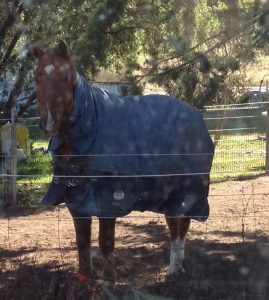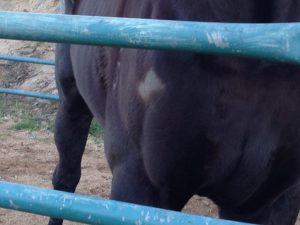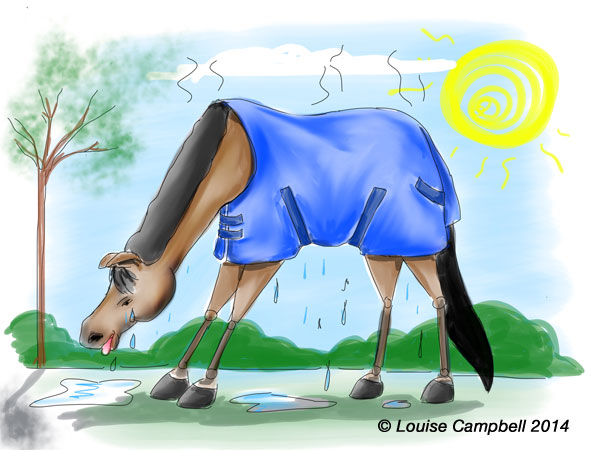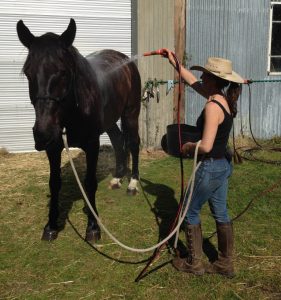
One of the horses I saw in winter rugs during my ride on that warm winters day – standing in the shade to try and cool down.
Overheating in rugs has got to be terribly unbearable for horses. I often see horses rugged 24 hrs a day in winter rugs, basically wearing winter rugs from the start of winter through to the end of winter and rarely having those rugs removed. It distresses me to see this. Just the other day we had a 21 degree day and I was riding in a singlet because I had become too warm in the long sleeve T shirt I was wearing and on winter days like that I love the feeling of the sun on my skin and like to get a good dose of vitamin D. As I was riding down the road, I saw horses standing in the shade because they were sweltering in winter rugs. It is so unfair and yet so common. I was trying to think of what I could do to help change this and the only thing I could think of was to raise awareness. Surely people don’t mean to be so cruel and inconsiderate to their horses, surely they are just not thinking. Perhaps they leave for work and its cold and return in the dark and its cold and are just unaware of how warm it can be outside in the middle of the day? Overheating is just one reason for horses not to wear rugs 24 hrs a day, some of the others reasons are outlined below. Please share this to bring awareness – the horses will thank you.
I believe that it is far better for a horse to be a bit cold than too hot.
Think back to a time when you were overheating and just couldn’t stand it any longer because it was unbearable and you just needed to rip some clothes off as quickly as possible. Or you wake up in the night because you are too hot and have to throw some blankets off. Our bodies can’t cope with overheating. Horses are the same – except they can’t just take their rugs off when they need to. Although I can’t scientifically prove it, I feel that continuous over heating could be doing a lot of long term damage to the horse’s bodily systems throwing their internal thermostats out of balance. Besides the aspect of great discomfort, this could cause them to not be able to function to their highest potential as they will not be in their highest state of health. If a horse is healthy and well fed with plenty of roughage (pasture or hay), has shelter (trees or man-made) and has room to move, their body is designed to be able to cope with the cold. Older horses have a lot more trouble dealing with cold but even they, in good health can cope. When it is cold and wet, that is when it is harder for horses to stay warm and horses who usually don’t want a rug may often really appreciate one in these conditions.
It is very much a situation of listen to your horse.
Some horses may want to be rugged for warmth and protection while others just do not want rugs. If they do not want rugs on they will often let you know via ears back, walking away or indicating that they will bite when you go to put the rug on, that is of course if the horse feels that it is allowed to express its feelings or opinions and give feedback. Perhaps it is not that they do not want to wear a rug at all, but that the rug they are wearing is very uncomfortable in how it fits or is just left on too long.
If you can’t be there to take winter rugs on and off daily it would be better not to rug at all.
If horses do choose to wear rugs then they should not be wearing them, particularly winter rugs, all throughout the day. I realise that due to itch some horses need to wear rugs almost all the time but even then, giving them time in the middle of the day without rugs is important.
Types of Rugs
Synthetic rugs, while being light are usually not breathable so overheating becomes even worse. Some of the very expensive top of the range synthetic rugs are stated to be breathable and have good thermoregulation but I have found that they are not quite as good as stated, so it is important to monitor your own horse in different temperatures. Some horses are hot horses and will much more easily overheat in rugs than others. If you put your hand in under the rug the horse should not feel “toasty”, if they do, then they are too hot. Canvass rugs probably breathe better but can be very heavy especially when wet.
Besides overheating there are several others factors that are important to be aware of.
A lot of rugs are just not comfortable. If we put rugs on, then we are responsible to make sure they are comfortable.
 Rubbing – If your horse is getting rub marks on the shoulders or neck or from the front chest strap or over the points of the hips, it means that the rug is not comfortable.
Rubbing – If your horse is getting rub marks on the shoulders or neck or from the front chest strap or over the points of the hips, it means that the rug is not comfortable.
Twisting and Pulling – Many badly designed rugs don’t stay straight, they twist crooked and pull on the horse. Some rugs stay straight but pull directly backwards and some cut down on the whither. Some do all of this at once. Heavy rugs over the top of cotton under rugs often pull the cotton rugs back so they start cutting into the horse in the chest area, some indications of this could be swelling and puffiness in this area in more extreme cases, other times you will just see lots of rug hanging out the back . Common areas affected are the base of the neck/chest, whither, points of the shoulders and the points of the hips. Badly designed rugs can make it uncomfortable for horses to have their heads down to graze as the chest strap cuts into the base of the neck. All of these discomforts impede the horse’s movement. Rugs can restrict the forward swing of the shoulders, which then flows on to affect other areas of the body, for example the spine and hindquarters, preventing the horse from moving freely and causing the horse to be in poor posture and with unhealthy biomechanical movement – the exact opposite of what we are trying to develop in them. Does your horse walk differently with the rug on, small steps or plaiting with the front legs?
Pressure points – Think of the times you have been uncomfortable and restricted when wearing heavy winter jackets or had the pressure of a heavy oilskin jacket affect you, or had a handbag or backpack cutting into you after wearing them for a while. How annoying and frustrating was it and how did it affect your posture and ability to move freely? The worse the fit and design of the rug and the heavier the rug, the bigger this problem is. Pressure points limit circulation and can even lead to sores and open wounds forming because they eventually can cut into the flesh, this is especially common in the whither area with heavier canvas rugs. These pressure points (shoulders, whither, chest, hips, top of croup) at first would be very uncomfortable just like having a wrinkle in your sock or stone in your shoe, you might try and put up with it for a while but then there comes a point where you just can’t stand it any longer and just have to fix it! When the discomfort can’t be removed the area goes numb which is not going to be healthy for the horse, shutting out circulation and sensory awareness in the nervous system. You may not always see physical signs of these pressure points on the body, as in sores or rub marks, but your horse will feel them so taking rugs off daily will give them some relief.
 Sunshine & Vitamin D – Horses need and love the sun on their skin. Just like us they need the sun for Vitamin D to be healthy. Lack of vitamin D is now recognised as one of the major causes of disease in humans and it can become a major problem for horses always covered in rugs. Fully rugged horses with neck rugs often have thin manes with mane hairs falling out due to a fungal infection caused by lack of sunlight.
Sunshine & Vitamin D – Horses need and love the sun on their skin. Just like us they need the sun for Vitamin D to be healthy. Lack of vitamin D is now recognised as one of the major causes of disease in humans and it can become a major problem for horses always covered in rugs. Fully rugged horses with neck rugs often have thin manes with mane hairs falling out due to a fungal infection caused by lack of sunlight.
 Horses love to be free and unrestricted to play, roll or run. When horses have a good gallop, hoon around and buck and kick, which is what happy healthy horses should do, how hot must they feel in their rugs after doing so ? But they can’t take them off once they have warmed up. As soon as we exercise, we start warming up and need to get some layers off.
Horses love to be free and unrestricted to play, roll or run. When horses have a good gallop, hoon around and buck and kick, which is what happy healthy horses should do, how hot must they feel in their rugs after doing so ? But they can’t take them off once they have warmed up. As soon as we exercise, we start warming up and need to get some layers off.
More than how they look, we need to consider how horses feel – that is what is more important. Many people rug horses so the horses don’t get so hairy and so that they look good and stay clean. That is OK as long as the horse’s comfort and well-being is equally considered. Remember growing a winter coat and getting dirty is natural – it is part of being a horse. Start to think about things from your horse’s point of view. Your horse will truly respect and appreciate you for that and you will have a happier, healthier horse.


